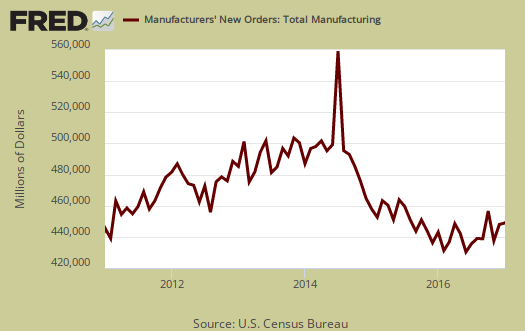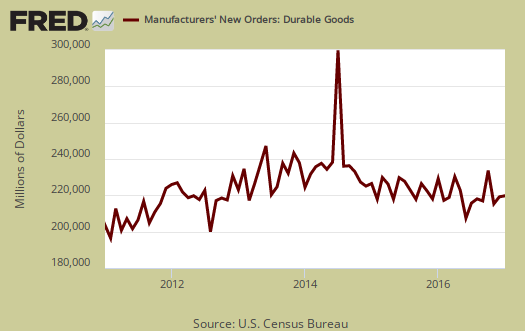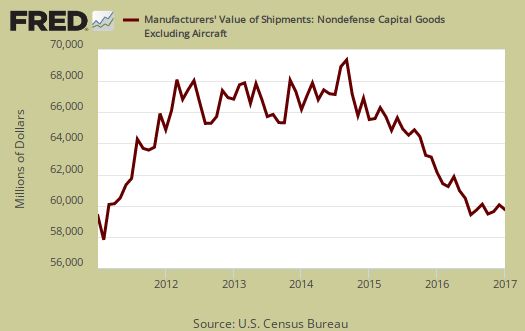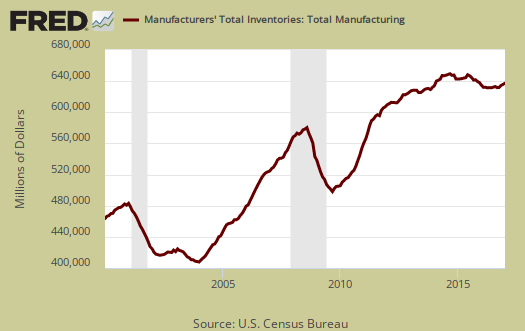The Manufacturers' Shipments, Inventories, and Orders report shows factory new orders increased by 1.2% for January. That's after December new orders rose by 1.3%. Durable goods new orders by themselves was revised to 2.0% from 1.8%. Transportation new orders were the monthly increase leader with a gain of 6.2%. This is after transportation equipment new orders had declined for two months. The year to date in comparison to the same time period in 2016, new orders for all manufacturing industries increased 5.5% while just durable goods new orders have had a much smaller 1.6% year to date gain. Inventories increased 0.2% for the month and are up 0.8% for the year. The Census manufacturing statistical release is called Factory Orders by the press and covers both durable and non-durable manufacturing orders, shipments and inventories.

Within transportation equipment, motor vehicles bodies & parts new orders increased by 0.8%. Aircraft new orders increased 69.8% in nondefense and in defense increased 62.2%. Ships and boats new orders decreased by -33.7%. There are other categories of transportation equipment not listed in the report. This month's gain was clearly caused by volatile aircraft, and the increase in autos & parts being minor.
Core capital goods new orders decreased by -0.1%. The previous month showed a 0.8% increase. Core capital goods are capital or business investment goods and excludes defense and aircraft. This is not so great, not something you want to see to indicate real economic growth, yet in essence, this is no change so not a dramatic decline.

Nondurable goods new orders increased by 0.4%, and are up a very high 9.5% for the year.

Shipments overall increased 0.2% for January. Durable goods shipments increased had no change. Nondurable goods shipments increased 0.4%. Core capital goods shipments decreased by -0.4%. Core capital goods shipments go into the GDP calculation. Below is a graph of core capital goods shipments.

Inventories for manufacturing overall increased 0.2%. Durable goods inventories increased 0.1%. Core capital goods inventories increased 0.1%. Nondurable goods inventories Increased 0.3%. For the same time this year, overall manufacturing inventories have increased 0.8%. Durable goods inventories have dropped by -0.7% for the year.

The inventory to shipments ratio was 1.31 unchanged from December 2016. When ratios increase it can imply economic sluggishness.

Unfilled Orders decreased by -0.4%. Durable goods unfilled orders also declined by -0.4%. Core capital goods unfilled orders increased by 0.4%.

Generally speaking this report shows gains on volatile aircraft. Minus aircraft the report is a so-so growth. It's not great news yet it certainly is not bad news either.
Part of this report goes into calculating GDP. The BEA takes this report, called M3, and uses the shipments values to calculate investment in private equipment, investment in software. Manufacturing inventories also goes into the changes in private inventories GDP calculation. At the bottom of this post is a little more information to estimate part of the GDP investment component.
The St. Louis Federal Reserve FRED graphing system has added individual NAICS data series from this report. If you're looking for a graph of some particular NAICS category, such as light trucks, autos & parts, or machinery, it might be found on FRED. Most news outlets source the Commerce Department, while technically correct, also makes it impossible for you, our beloved detailed reader, to find the actual statistical report and data which you might be focused in on. There is much more detail in the statistical tables published by the Census website for manufacturing statistics.

Recent comments